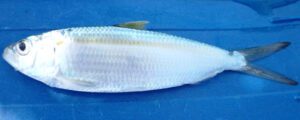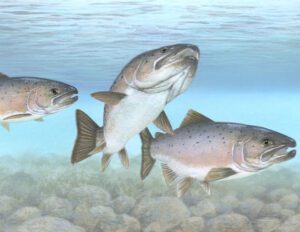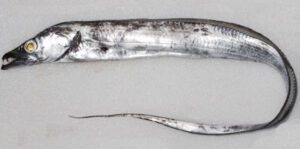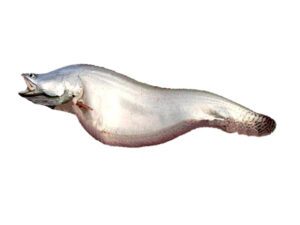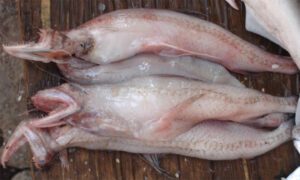The Albacore fish or Longfin Tuna fish is a species of tuna of the order Perciformes. It is mainly found in the temperate and tropical waters throughout the world in the epipelagic and mesopelagic zones.
It is known by many other different names such as Albacore Tuna, Aahi Taria, Bastard Albacore, Long-fin Tunny, Long-finned Tuna, Bonito, Langvin Tuna etc. And also called by many other different names in different parts of the world.
There are 6 distinct stocks known throughout the world in Atlantic, Pacific and Indian Oceans, as well as the Mediterranean Sea.
The Albacore fish is economically a very important fish and is a target of commercial and recreational fisheries.
This fish species was originally the basis for the United States tuna-canning industry and is no less important today. It makes up significant percentages of the GDP of various Pacific nations.
Total population of this species is decreasing. And it is listed as Near Threatened by the IUCN, mainly because of the threat of overfishing. Read some more information about this fish species below.
Albacore Fish Characteristics
The Albacore fish has an elongate, streamlined, fusiform body. They have conical snout, large eyes and remarkably long pectoral fins.
In case of coloration, their body is a deep blue dorsally and shades of silvery white ventrally.
And their body is covered by small scales. Their pectoral fins begin slightly before the first dorsal fin and extend well beyond the front of the anal fin (usually as far as the second dorsal finlet, and often as long as 30 percent of the fish’s total body length).
The fins are dark blue on the top, but change to a medium yellow color on the underside. Their caudal fins is silvery white.
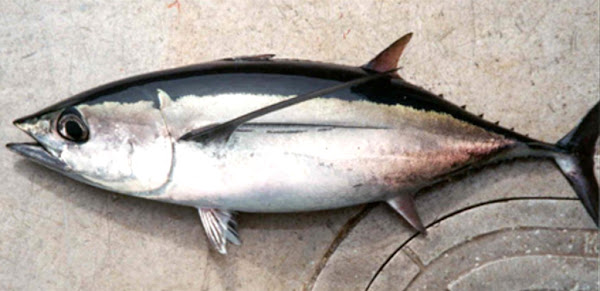
The mature Albacore fish can reach up to 140 cm total body length. Maximum recorded body weigh of this fish is 63 kg. Photo and info from Wikipedia.
Diet
The Albacore fish are pelagic predators. They are feed on fish crustaceans and cephalopods.
They are unique among tuna in that their primary food source is cephalopods, with fish making up a much smaller portion of their diet.
Breeding
Breeding of the Albacore fish generally occurs from November to February, and is oviparous.
Generally a mature female with about 20 kg body weight, can produce between 2 and 3 million eggs per spawning.
Their eggs fertilize outside the female’s body. And the eggs generally take 1-2 days for hatching.
Uses
The Albacore fish is a very popular food fish. It is highly appreciated in the market.
And it is generally marketed fresh, frozen, canned or smoked. It is eaten broiled, fried, steamed and microwaved.
Special Notes
The Albacore fish is very important in many commercial fisheries throughout the world. It is managed throughout most of it’s range. These fish have been found inhabiting depths of 0-600 meters.
And the large fish of up to 21 kg, generally inhabit at depths from 0 to 450 meters with a maximum abundance between 250 and 300 meters. This water depth (250-300m) has a water temperature of 25-15 °C.
The Albacore fish grow very fast. The juveniles remain close to the place where they hatched for the first year of their lives. And they begin to migrate after their first year.
On an average, the fish generally reach maturity at around 5-6 years. And their average lifespan is about 11-12 years. However, review full breed profile of the Albacore fish in the table below.
| Name | Albacore |
| Kingdom | Animalia |
| Phylum | Chordata |
| Class | Actinopterygii |
| Order | Perciformes |
| Family | Scombridae |
| Genus | Thunnus |
| Species | T. alalunga |
| Binomial Name | Thunnus alalunga |
| Other Names | Albacore Tuna, Aahi Taria, Bastard Albacore, Long-fin Tunny, Long-finned Tuna, Bonito, Langvin Tuna etc. |
| Breed Purpose | Mainly food |
| Weight | Can reach up to about 63 kg |
| Special Notes | Very important commercial fisheries throughout the world, grow very fast, 11-12 years of average lifespan, reach maturity at around their 5-6 years of age, mature females can generally lay between 2 and 3 million eggs per spawning, used mainly for food |
| Breeding Method | Natural |
| Climate Tolerance | Native climates |
| Body Color | Deep blue dorsally and shades of silvery white ventrally |
| Rarity | Common |
| Availability | Worldwide |

